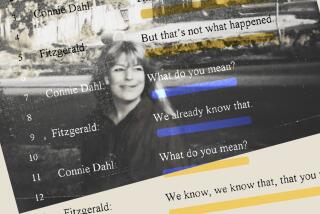Dog’s Cry Cited as Trial Focus Shifts to Deaths : Simpson case: Witnesses tell of victims’ last known acts. Juror who shares defendant’s doctor is replaced.
- Share via
Jurors in the O.J. Simpson murder trial heard Tuesday from a man who described the “plaintive wail” of a dog that prosecutors believe establishes the time of the June 12 killings, testimony that capped a day in which other witnesses described the final known acts in the lives of victims Ronald Lyle Goldman and Nicole Brown Simpson.
Testimony about the hours leading up to the murders dominated the court session, but the day also featured the latest change in the jury, as one more panelist was removed and replaced by an alternate. Also Tuesday, Goldman’s sister, Kimberly, testified briefly, becoming the first member of that family to appear on the witness stand.
And as the session ended, lawyers for the two sides demonstrated yet again the testy nature of the proceedings, engaging in a spirited debate over the propriety of Deputy Dist. Atty. Marcia Clark’s wearing a small angel pin to signify her sympathy with the families of the victims. Superior Court Judge Lance A. Ito ordered Clark to stop wearing the pin, at least for now.
The time of the murders is among the most hotly disputed issues in the Simpson trial, and it surfaced in testimony for the first time Tuesday. Defense attorneys have long argued that the killings could have occurred as late as 11 p.m. on June 12, when Simpson was en route to the airport and his whereabouts thus accounted for. Prosecutors have said the murders occurred earlier, however, closer to 10:15 p.m., giving Simpson enough time to carry out the knife attacks, return home and catch his limousine.
Simpson is charged with the murders of his ex-wife and Goldman. He has pleaded not guilty.
As they sought to establish the time of death, prosecutors called upon a witness who first emerged in public last summer giving testimony at Simpson’s preliminary hearing. That witness, screenwriter Pablo Fenjves, lives a short distance from Nicole Simpson’s condominium, outside of which the two bodies were discovered shortly after midnight on June 13.
Fenjves said he was upstairs in his bedroom watching the 10 p.m. news when “10 to 15 minutes into it, I became aware of a barking sound.” The sound caught his attention, Fenjves said, because it was “persistent” and “unusual.”
Referring to his testimony during the preliminary hearing, Fenjves added: “I described it at the time as a plaintive wail. It sounded like a very unhappy animal.”
Although jurors did not hear from them Tuesday, prosecution witnesses scheduled to testify in coming days are expected to describe how they found Nicole Simpson’s brown-and-white Akita near her home shortly after 10:30 p.m. At the preliminary hearing, those witnesses said the dog had blood on its paws and was behaving strangely. Eventually, the same dog led a couple back to Nicole Simpson’s condominium, straining on its leash and pulling them to where the two bodies lay in deep pools of blood.
Johnnie L. Cochran Jr., Simpson’s lead trial attorney, tried to shake Fenjves’ recollection of the exact time, noting that a police report quotes him as saying that he heard the dog’s wailing between 10:15 and 10:30 p.m., not the more specific window of time to which he testified Tuesday and at the preliminary hearing. But Fenjves said the police report did not quote him accurately, and he stood by his testimony.
“Is it your testimony, sir, that on the night of June the 12th, 1994, between 10:15 and 10:20, you began to hear a dog barking in an unusual way?” Clark asked.
“Yes, it is,” Fenjves said.
“Thank you, sir,” Clark said. “I have nothing further.”
In other testimony Tuesday, employees of the Mezzaluna restaurant, where Goldman worked and where Nicole Simpson ate her last meal, said that Simpson and her party left the restaurant that evening before 9 p.m. and that Goldman appeared to be heading out shortly before 10 p.m., carrying a pair of glasses that Nicole Simpson’s mother dropped as she was leaving the restaurant.
One of those witnesses, Stewart Tanner, said he had planned to meet Goldman later that evening and go to a Marina del Rey Mexican restaurant. Goldman never called.
“Did you hear from Ron?” Clark asked.
“No,” Tanner responded. “I did not.”
“Did you ever hear from him again?” Clark asked.
“No, I did not,” he answered.
As the prosecution moved from its presentation of evidence regarding domestic violence to testimony about the night of the killings, the government lawyers were confronted with a dwindling jury of shifting racial and gender composition.
Explaining only that he had been confronted with “some delicate matters,” Ito removed one panelist, a 63-year-old white legal secretary for a major law firm. He replaced her with an alternate.
The replacement, whose number was drawn by lot, is a 54-year-old black post office employee from Long Beach. His addition to the panel brought the number of African American jurors in the case to nine and reduced the number of white panelists to one. The new juror--who said in his juror questionnaire that he had virtually no opinions about the case--rose slowly when his number was called, crossed in front of several of his colleagues and took his place on the panel that will decide Simpson’s fate.
The excused juror became the third to leave since the panel was assembled. But while claims of failing to disclose a previous meeting with Simpson caused one dismissal and an instance of domestic violence forced the removal of another, the latest lost her seat for a far more mundane reason: She uses the same arthritis doctor as Simpson. Now that defense lawyers intend to call that doctor as a witness, she can no longer serve on the panel.
Her removal and replacement with a male juror also shifts the gender balance on the jury. It now consists of seven women and five men.
And more changes in the jury composition may be in the works. According to sources, Ito has ordered investigators from the Sheriff’s Department to explore allegations of possible misconduct by one or more jurors. That investigation--which includes allegations that at least one juror may have had printed material such as maps--is not complete, the sources added.
Although many analysts have focused on the racial and gender composition of the Simpson jury--he is a black man charged with killing two whites, and domestic abuse is a major underlying issue in the case--some experts said they do not expect the changing jury demographics to affect the verdicts.
“I believe that if African Americans are presented with compelling evidence, they will reach a just verdict,” and Albert De Blanc Jr., a Los Angeles defense lawyer. “I don’t believe race ultimately is a factor in the verdict. I don’t think African Americans would abrogate their duty and responsibility to reach a just verdict simply by virtue of the fact that O.J. Simpson is an African American.”
Lawyers for the prosecution and defense met privately with Ito for more than two hours Tuesday morning discussing jury issues, but when court finally resumed, the prosecution began unfolding the second phase of its case--leaving behind for now the allegations of domestic abuse by Simpson and moving to its theory of how the murders were committed.
Essential to that is the question of timing, and the witnesses who took the stand Tuesday began to narrow the window of time during which the murders could have occurred. Although the testimony about the wailing dog was the most definitive in that regard, employees of the Mezzaluna restaurant also were called to help establish the last known sightings of the victims.
Karen Crawford, who managed the Mezzaluna on June 12, said Goldman had finished work at 9:33 p.m., a recollection she based on his time card, which prosecutors displayed for the jury. Goldman spent a little time in the restaurant before leaving, but Crawford said she saw him leave about 9:50 p.m.
Goldman lived a short walk away--one witness estimated that it was less than a two-minute walk. Prosecutors say he would have had time to go home, change out of his work clothes and head over to Nicole Simpson’s house to return the eyeglasses that her mother dropped outside the restaurant.
Nicole Simpson lived about three blocks from the restaurant.
As she did during last summer’s preliminary hearing, Crawford described receiving a telephone call from Nicole Simpson’s mother after the party left the restaurant inquiring about her eyeglasses. Crawford said she first looked inside the restaurant and could not find them but then noticed them outside the restaurant near the curb.
She placed them inside a white envelope, Crawford testified. Clark displayed that evidence, sealed in a plastic bag, for Crawford, who recoiled slightly as the blood-soaked envelope was held in front of her.
When his body was found, Goldman was not wearing the black pants and white shirt he had worn to work that night. Clark showed the pants and shirt to Crawford Tuesday afternoon, causing the restaurant manager to briefly break down in tears.
Clark paused to see if Crawford could continue, and the witness insisted that she could: “I’m OK,” she whispered softly. “I’m OK.”
In cross-examining Crawford, Simpson attorney Robert L. Shapiro steered clear of any subject that might further rattle her. “I will not ask you any questions that upset you,” he promised at the outset. He generally avoided sensitive topics but suggested that Nicole Simpson and Goldman might have had more of a relationship than a passing friendship.
That suggestion, made in a series of questions posed to Crawford, mystified some legal analysts.
“Perhaps the defense has concluded that painting Nicole Brown as a woman on the fast track might sufficiently irritate some jurors to motivate a finding of reasonable doubt,” said Peter Arenella, a UCLA law professor. “The defense might also want to suggest to the jury that Ron Goldman had more in mind than returning the glasses when he went to Nicole’s condo. If his purpose in going to her condo was social, then perhaps he would have taken a shower at home first. Anything that lengthens the time Goldman spent at his apartment supports the defense argument that those murders could not have occurred before 10:30 p.m.”
But Crawford said she had no reason to believe that they were more than casual friends.
And prosecutors sought to show that Goldman was moving quickly after he left the restaurant, not dawdling at home before heading to Nicole Simpson’s condominium with the glasses. To make that point, they called Goldman’s sister, Kimberly, for a brief appearance.
To the relief of defense lawyers, Kimberly Goldman did not lose her composure during her testimony, and she stayed on the stand for only a few minutes--just long enough to tell the jury that when she went to her brother’s apartment to get a suit for his funeral, she found his work clothes hastily draped over a door.
Cochran did not pose any questions to her.
As the court day ended Tuesday, the two sides engaged in a heated debate over one of the many marginal issues that have regularly erupted in the Simpson case. This time, the dispute was sparked by Cochran’s annoyance at a small piece of jewelry that Clark sometimes wears to court--a gold angel pin resembling one that family members of the victims wear to signify their sympathy for Goldman and Nicole Simpson.
Although he called Clark a “fine lawyer,” Cochran insisted that it was inappropriate for her to show such obvious sympathy with the families, some of whose members are taking the stand as prosecution witnesses.
“She has it on,” Cochran said of his opponent and her pin. “She shouldn’t have it on. She knows she shouldn’t have it on.”
Clark ridiculed Cochran’s objection, urging Ito to deny “this ridiculous request” and accusing Cochran of trying to strip the case of any reference to the murder victims. Clark said she was “shocked at counsel’s denunciation of human emotion and sympathy.”
Clark added of the pin: “It’s a very small show of support, very tasteful.”
Ito conceded that he was not a jewelry aficionado. “To tell you the truth,” he acknowledged, “jewelry is not my forte, as one who wears plastic watches.”
But the judge has ordered everyone in his courtroom to refrain from any displays of support, and he ordered Clark to keep the pin off when she returns to court today. He did not address small pins often worn by members of Simpson’s family to demonstrate their faith in him. Although his mother and other relatives have worn those pins, his lawyers have not.
When the two sides return to court this morning, prosecutors are expected to push forward with witnesses who will attempt to nail down the time of death. Among those on the prosecution witness list for today are neighbors who say they found Nicole Simpson’s dog wandering throughout the community with bloody paws.
Their testimony is intended to bolster Fenjves’ account of the wailing dog and to show that multiple witnesses offer accounts supporting the notion that the murders were committed before 10:30 p.m.
Defense attorneys have belittled that entire portion of the prosecution case, suggesting that it is unfair to place so much credence on the wandering and wailing of a dog.
In other business Tuesday, a spokeswoman for the district attorney’s office said the prosecution team may soon by rejoined by Deputy Dist. Atty. William Hodgman, who was rushed to a hospital last month complaining of chest pains. His absence has handicapped prosecutors, but spokeswoman Suzanne Childs said he expects to return Thursday.
According to Childs, Hodgman, the senior official assigned to the case, will act as a manager of the case rather than as a trial lawyer, working more behind the scenes than in court.
Times legal affairs writer Henry Weinstein contributed to this story.
* RELATED STORIES: A8
More to Read
Sign up for Essential California
The most important California stories and recommendations in your inbox every morning.
You may occasionally receive promotional content from the Los Angeles Times.











